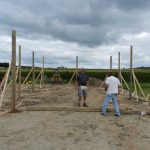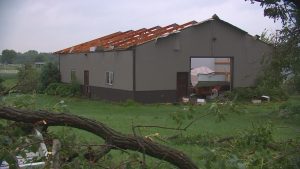I’ve Hit a Boulder, What do I do?
When I was building, the rock the size of a Volkswagon was generally parked in the last hole being dug on any given project.
 After digging all of the other holes – moving the building to avoid the rock just never felt like a viable option. I hated digging holes to begin with as they always entail dealing with the unknown, what is lurking beneath the ground’s surface. The Captain of the Titanic had some of these same feelings about icebergs, you never know what is below the surface until you hit it.
After digging all of the other holes – moving the building to avoid the rock just never felt like a viable option. I hated digging holes to begin with as they always entail dealing with the unknown, what is lurking beneath the ground’s surface. The Captain of the Titanic had some of these same feelings about icebergs, you never know what is below the surface until you hit it.
Reader Greg in Staunton writes:
“I’m building a 24 x 32 pole barn. Successfully dug all post holes but one down 4 feet. Hit limestone boulder on a corner hole about 1 foot down. How can I secure this post so it doesn’t become a weak link in an otherwise solid construction. The rock is not level (about 30 degree slant toward the outside of the building wall. I’d appreciate your input.”
I used to use a steel stake used for anchoring concrete forms and a sledge hammer to investigate prior to digging. Once the building hole locations were laid out, said stake could be driven in at each hole location to determine if there were challenges ahead which could not be seen at the surface. At least by doing the stake test, we could determine with some degree of accuracy where rocks might lay, and if we thought we were going to have one, negotiate with the new building owner about shifting the building location to avoid the rock.
 My first choice for a solution would be to dig the rock out. Even if it leaves a crater numerous feet across, a sonotube can be placed at the column location, properly backfilled around and the post can be placed in the tube. The excavation is probably going to involve some heavier equipment, like a backhoe.
My first choice for a solution would be to dig the rock out. Even if it leaves a crater numerous feet across, a sonotube can be placed at the column location, properly backfilled around and the post can be placed in the tube. The excavation is probably going to involve some heavier equipment, like a backhoe.
Behind door number two – rent a jackhammer. Unless you have hit solid granite, most rocks can be broken apart by use of either a jackhammer or a hammer attachment mounted to either a skid loader or a backhoe. The jackhammer is going to be far more physical, but less of an investment.
 The last option is to consult with the engineer who designed your building to provide an engineered fix to the problem. At only a foot below the surface, this one could be tough. In some cases I have seen engineers have rebar pins epoxied into the top of the rock and the column placed upon the pin. The balance of the hole can then be backfilled with concrete to prevent uplift or overturning.
The last option is to consult with the engineer who designed your building to provide an engineered fix to the problem. At only a foot below the surface, this one could be tough. In some cases I have seen engineers have rebar pins epoxied into the top of the rock and the column placed upon the pin. The balance of the hole can then be backfilled with concrete to prevent uplift or overturning.
This last option is not one to undertake on your own without the involvement of an engineer, as you don’t want this to become the weak link which results in the failure of your beautiful brand new building.







The building site that we are looking at – and it’s really the only spot due to the view and other pre-existing buildings – is on top of large areas of ledge. This ledge should be very stable, since we’re talkin’ 25′-50′ long sections showing through the ground, which is fairly level in this area. Is it possible to put a pole building on ledge like this?
Tracy ~ Post frame buildings can be constructed successfully upon most any type of buildable soil condition, including bedrock. If it is indeed bedrock, then yes it should be fairly stable. My first choice would be to use equipment to chip holes into the bedrock – a ram hoe attachment on a backhoe will get through just about anything. In the event this is unsuccessful, your building engineer should be able to design a way to attach the columns directly to the bedrock. This usually involves drilling into the rock and using epoxy to permanently affix rebar pins into the rock. The columns can then be attached to the pins and concrete placed around them to prevent uplift.